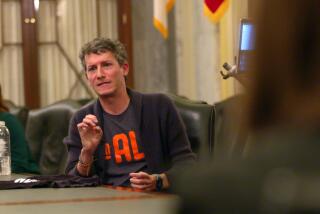Recognition flickers, then fades
- Share via
Now in the half-light she sees life dimly, straining to recognize those she only vaguely remembers. Sometimes they snap clearly into focus, but mostly the glow of her memory is muted, and the images before her vague. Her existence, a faint hold on reality, is fading into the darkness of Alzheimer’s disease.
She’s my sister, and I know that if she were aware of it, she would resent the mental frailty that the affliction is imposing on her. Even now there are moments when she rages, as the poet Dylan Thomas would say, “against the dying of the light.”
I don’t know that she was ever told specifically that she has the disease, but the last time I saw her, in a Modesto nursing home, she was vowing to battle against whatever was eroding her cognition.
“You know me,” she has always said, “I’m a fighter.”
She’s had to be. Born with strabismus, she bore the taunts of “cross-eyes” throughout her troubled childhood, an invective hurled at her by an abusive stepfather as well as neighborhood bullies. I am two years her senior and more than once took a beating defending her. She’s never forgotten it.
A longtime smoker, in later years she developed cancer, now in remission, but still sneaks in a cigarette once in a while, when her husband or a relative pushes her in a wheelchair around the grounds of the nursing home.
It was a bleeding ulcer that took her to a hospital this time. Even before then, her husband says, he could see her slipping into the half-light. Treated for the ulcer, she was then diagnosed as being in the first stages of Alzheimer’s. She was transferred to the nursing home, where she has refused to eat, either sitting in utter silence or erupting in rage.
A physician, speculating on her refusal to eat, said, “Maybe she just wants to die.”
I can’t believe she does, but I also can’t help wondering what kind of life remains for her as the half-light fades. Is there nothing left in the darkness, no stars to see by, no music to hear?
An estimated 4.5 million Americans are afflicted with Alzheimer’s. Ronald Reagan’s death has spurred the kind of interest in the disease that my sister’s fading life never could. When the former president’s illness was disclosed, government spending on research was at about $300 million a year. This year it could approach $1.4 billion.
The use of embryonic stem cells in Alzheimer’s research, once scorned by conservatives, is receiving new attention, especially after Nancy Reagan announced her support last spring. Presently there is no cure, and although the tools of diagnosis are becoming more efficient, one shudders at the words of a physician quoted in The Times as saying, “The gold standard for diagnosis is autopsy.”
I flew up to see my sister again a few days ago. She recognized me at once, shouting my name down a long hallway. She was strapped into a wheelchair being pushed by her husband. The strap was to keep her from “escaping,” as she has attempted at least twice. She is a prisoner, in one sense, of her environment, and also of the disease that is increasingly confining her to the dungeons of her mind.
Her recognition of me continued sporadically for the several hours I was with her, but when her mind wasn’t on me, she sat in her wheelchair staring at the ground, looking up to abruptly say my name, as though each time suddenly realizing I was there. As she repeated my name, she would reach out to take my hand, cling to it for several minutes and then gradually release her grip as she faded back into silence, like a child cowering in a dark forest.
The disease affects her husband in many ways too, not the least of which is seeing the woman he shared his life with becoming a different person, emptying of everything they knew together. The cost of her disease is also rising beyond government subsidies into a realm where, living on Social Security, he is unable to pay.
Unless she is the recipient of a miracle, of which there are few, and unless her willingness to fight achieves a reversal of her disease, my sister will slip gradually down the long incline of her condition, into a world we can only guess at. My hurt for her is deep and frustrating.
The number of Alzheimer’s patients is increasing, and no one seems to know why. Research is underway, but even with the full use of stem cells, any kind of cure is years, possibly decades, away. It’s too late for my sister. But one hopes that it will come in time for others who, unknowingly, are walking only briefly in the full light of life.
*
Al Martinez’s column appears Mondays and Fridays. He’s at [email protected].


